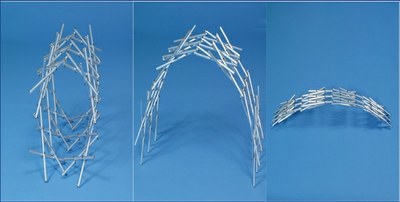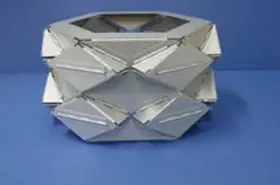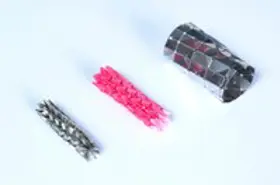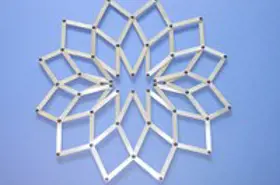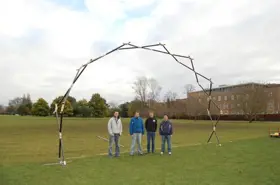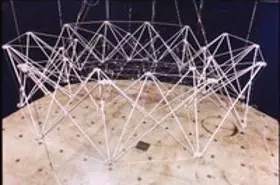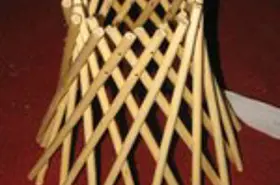Research undertaken by the Special Structures Group, Department of Engineering Science, University of Oxford
Special Structures Group
Our Research
Motion structures are a novel and unique type of engineering structures, which can be packaged for transportation and expanded at the time of operation. They retain the functionality of conventional structures, but are also able to undergo large geometric transformations. In aerospace engineering, they are termed deployable structures whereas in civil and mechanical engineering their names include retractable, collapsible and expandable structures.
You may not realise it, but hundreds of motion structures surround you today. Foldable tables, chairs, stands; tents and umbrellas; shop window shutters, FM radio aerials and even hairnets are all examples of motion structures. What makes them similar is that they all change their geometry to perform a practical purpose. For example, a hairnet is a small object when unused, no bigger than the size of your thumb; when it is in use, it expands to cover the whole of your head! The number of applications for motion structures is almost limitless. In fact, Mother Nature herself has been making use of them for around 4 billion years. Young leaves are folded in certain ways inside the bud on a tree; some flowers open the petals during the day to attract bees to their pollen, but close at night to regulate their biological functions; insect wings, when expanded, can be up to five times their folded size; and some fish, reptiles and birds have special bones in their mouths that can dislocate to enlarge the animal's mouth.
Currently, however, it is space technology that is taking up the mantle for research into motion structures. Assemblies, such as satellites, that need to be deposited into space, must be packaged as small as possible to fit into a launch vehicle. However, problems do exist. Devices can often fail at the critical moment of their expansion (remember the antenna that failed to deploy on the Galileo mission to Jupiter in the 1990s). The structures are often stored in their compacted shape for many months under very severe conditions of heat and cold, and testing the devices under a gravity-free environment found in space is usually difficult to carry out. If, when the devices are ready to open, the mechanisms necessary for their deployment do not work correctly, millions of pounds will be wasted on aborted missions. Hence, aerospace engineers are always after designs with good packaging efficiency and operational reliability.

The use of motion structures, however, is not limited to just aerospace assemblies. Another innovative application for motion structures is in the treatment of diseased arteries. Devices can be placed into a diseased artery with minimal surgery by inserting them into a remote vessel (usually the leg artery), and passing them through other vessels until they reach the diseased area. Repair of abdominal aortic aneurysms is one such treatment area. The device must be small enough to fit into the leg vessel and flexible so that it can manoeuvre through the twists and turns in the body.
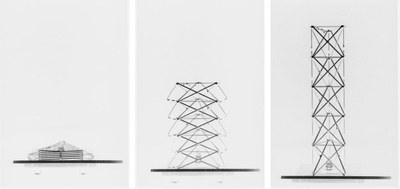
Motion structures have long been in use and they remain today at the forefront of scientific endeavour. They are easy to assemble, easy to use and easy to store and, consequently, are in constant demand to overcome engineering problems that exist in all walks of life.
Research Areas
Graduate Study and Research Opportunities
Motion structure is one of the new research front in the otherwise traditional structural/mechanical engineering. It has been found difficult to have a precise limit on dimension, scale or shape of the structures involved at a recent conference on the subject. Artists, architects, civil, aerospace and material engineers, zoologists and medical professions all find that they have encountered or intend to creat structures which can undergo large geometric transformation. Therefore, many new research opportunities arise. We are always seeking students with good knowledge in mechnical engineering, structural engineering or medical engineering to study deployable structures in Oxford towards a higher degree. There are quite a number of scholarships available each year. Some are for British students, e.g. CASE scholarships (Cooperative Awards in Science and Engineering) awarded by the EPSRC (the Engineering and Physical Sciences Research Council); the others are for overseas students such as Rhodes Scholarships etc. . Also the university has set aside a large sum of fund to support postgraduate studies. Last year in deployable structures research alone, four graduate students, from Britain, China, Hungary and Japan respectively, received full scholarships to read D. Phil (Ph.D as called in most other universities). All the scholarships are awarded purely on academic merits alone.
If you feel that you have a strong academic background and are interested in the subject, please write to Zhong at the address provided below for further information. As the deadlines for some scholarships are as early as November, please do remember to take prompt action. You can read Graduate Studies Prospectus on line and request application forms.
In addition, we also have schemes for visiting students and academics. Some final year undergraduates from the EU have completed their graduate projects here. You may also contact Zhong if you like to come as a visiting student.
